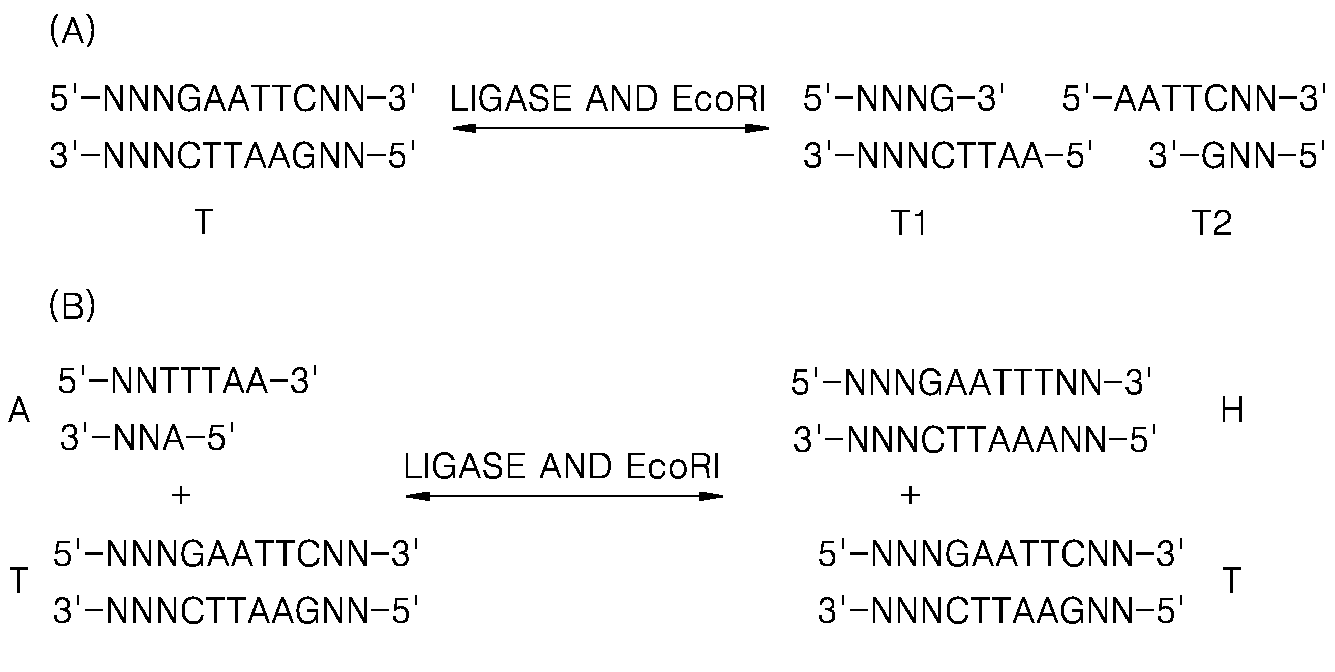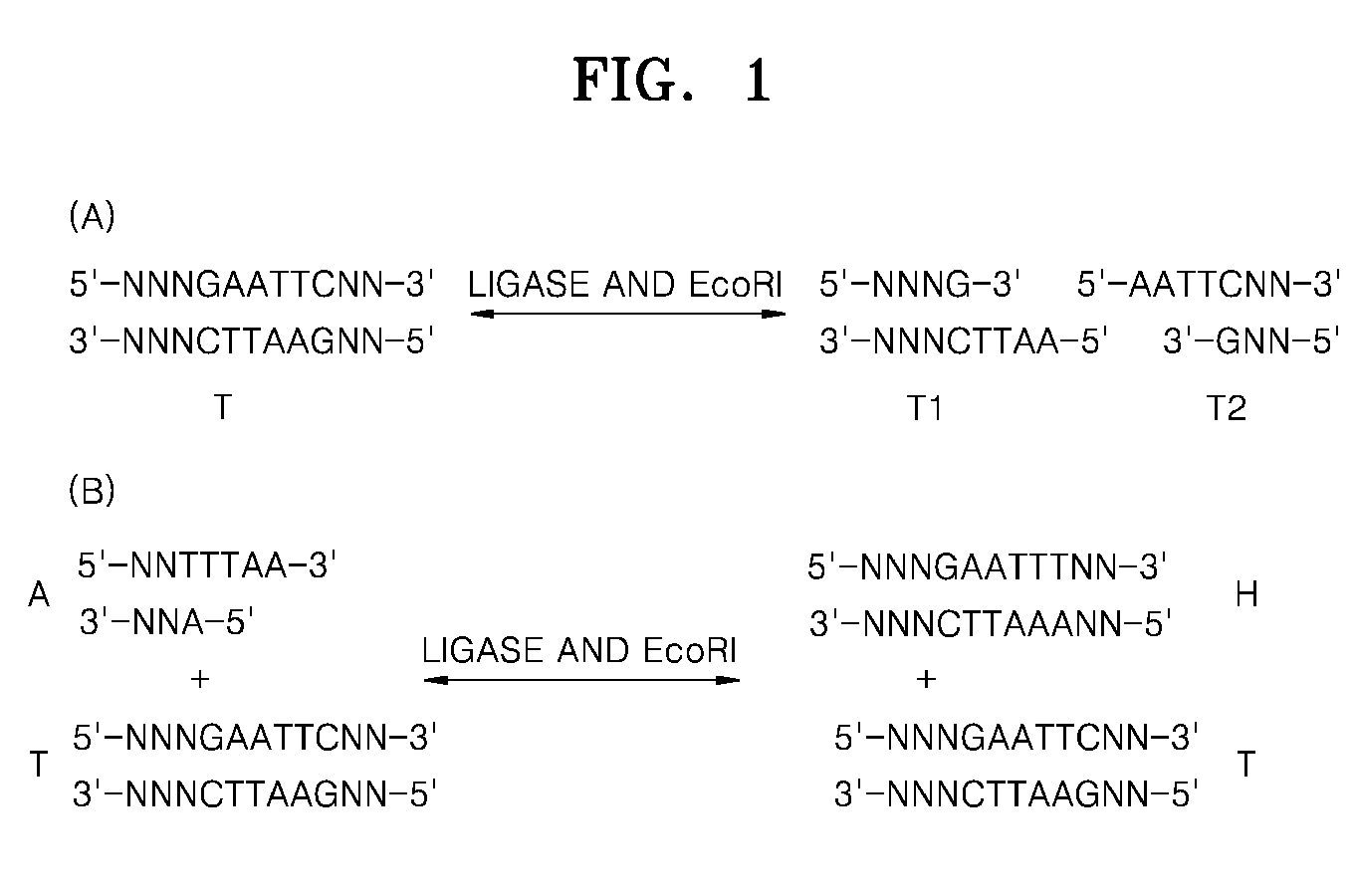Method of amplifying a target nucleic acid by rolling circle amplification
a target nucleic acid and amplification technology, applied in the field of amplifying target nucleic acids by rolling circle amplification, can solve the problems of inability to perform a single-strand circular, the method of performing rca in the presence of both ligase and endonuclease has not been disclosed, and the difficulty of preparing a single-strand circular is not easy to achiev
- Summary
- Abstract
- Description
- Claims
- Application Information
AI Technical Summary
Problems solved by technology
Method used
Image
Examples
experimental example 1
Compatibility of Restriction Enzyme Buffer and DNA Polymerization Buffer
[0049]The current Experimental Example was performed to identify that a buffer used for a restriction enzyme reaction can be compatible with respect to a buffer used for DNA polymerization.
[0050]1500 ng of Lambda DNA (Bioneer, Korea) was added to 10 μl of NEB buffer 4 (consisting of 50 mM potassium acetate, 20 mM Tris-acetate, 10 mM magnesium acetate, and 1 mM dithiothreitol, pH 7.9 at 25° C.), and 3 units of Hpy188III were added thereto. The obtained solution was reacted at room temperature for 10 minutes (use of restriction enzyme buffer). Hpy188III had a recognition site of TCNNGA, and is a type IIs. In addition, 1500 ng of Lambda DNA (Bioneer, Korea) was added to 10 μl of Mg2+ and ATP-added Bst DNA polymerase buffer [1× Bst buffer (20 mM Tris-HCl, 10 mM (NH4)2SO4, 10 mM KCl, 2 mM MgSO4, 0.1% Triton X-100, pH 8.8 at 25° C.), 7.5 mM Mg2+, 0.6 gM of each primer (SEQ ID NO: 4 and 5), 0.3 mM dNTP each, 5 units of...
experimental example 2
Compatibility of DNA Buffer and Ligase Buffer
[0052]The current Experimental Example was performed to identify that a buffer used for a DNA polymerization reaction can be compatible with respect to a ligase buffer.
[0053]1500 ng of Lambda DNA (Bioneer, Korea) was added to 10 μl of T4 DNA ligase buffer (consisting of 50 mM Tris-HCl, 10 mM MgCl2, 1 mM ATP, 10 mM Dithiothreitol, pH 7.5 at 25° C.), and 3 units of Hpy188III and 3 units of T4 DNA ligase were added thereto. The obtained solution was reacted at room temperature for 20 minutes (use of ligase buffer). Also, 1500 ng of Lambda DNA (Bioneer, Korea) was added to 10 μl of Mg2+ and ATP-added Bst DNA polymerase buffer [1× Bst buffer (20 mM Tris-HCl, 10 mM (NH4)2SO4, 10 mM KCl, 2 mM MgSO4, 0.1% Triton X-100, pH 8.8 at 25° C.), 7.5 mM Mg2+, 0.6 pM each primer, dNTP 0.3 mM each, Bst DNA polymerase 5 unit, 1 mM ATP, SYBR 2×], and 3 units of Hpy188III and 3 units of T4 DNA ligase were added thereto. The obtained solution was reacted at roo...
experimental example 3
Equilibrium State Of Product In Solution In Which Ligase And Restriction Enzyme Co-Exist
[0055]The current Experimental Example was performed to identify a change in an equilibrium state of a product when a solution including a target nucleic acid and two hairpin oligos is treated with a ligase, with a restriction enzyme, and with both the ligase and the restriction enzyme.
[0056]20 μl of a reaction solution included 0.5 μM target DNA (SEQ ID NO: 1), 5 μM each hairpin oligo (SEQ ID NOS: 2 and 3), 1× Bst buffer (20 mM Tris-HCl, 10 mM (NH4)2SO4, 10 mM KCl, 2 mM MgSO4, 0.1% Triton X-100, pH 8.8 at 25° C.), 7.5 mM Mg2+, 0.6 μM each primer (SEQ ID NO: 4 or 5), 0.3mM dNTP each, 5 units of Bst DNA polymerase, 1 mM ATP, and SYBR 2×. 3 units of T4 DNA ligase (Lane 1) and 3 units of T4 DNA ligase and 3 units of a restriction enzyme Hpy188III were added thereto in a ratio of 1:1 (Lane 2), 3 units of a restriction enzyme Hpy188III (Lane 3) were added thereto. The obtained solution was reacted at ...
PUM
| Property | Measurement | Unit |
|---|---|---|
| Temperature | aaaaa | aaaaa |
| Temperature | aaaaa | aaaaa |
| Molar ratio | aaaaa | aaaaa |
Abstract
Description
Claims
Application Information
 Login to View More
Login to View More - R&D
- Intellectual Property
- Life Sciences
- Materials
- Tech Scout
- Unparalleled Data Quality
- Higher Quality Content
- 60% Fewer Hallucinations
Browse by: Latest US Patents, China's latest patents, Technical Efficacy Thesaurus, Application Domain, Technology Topic, Popular Technical Reports.
© 2025 PatSnap. All rights reserved.Legal|Privacy policy|Modern Slavery Act Transparency Statement|Sitemap|About US| Contact US: help@patsnap.com



